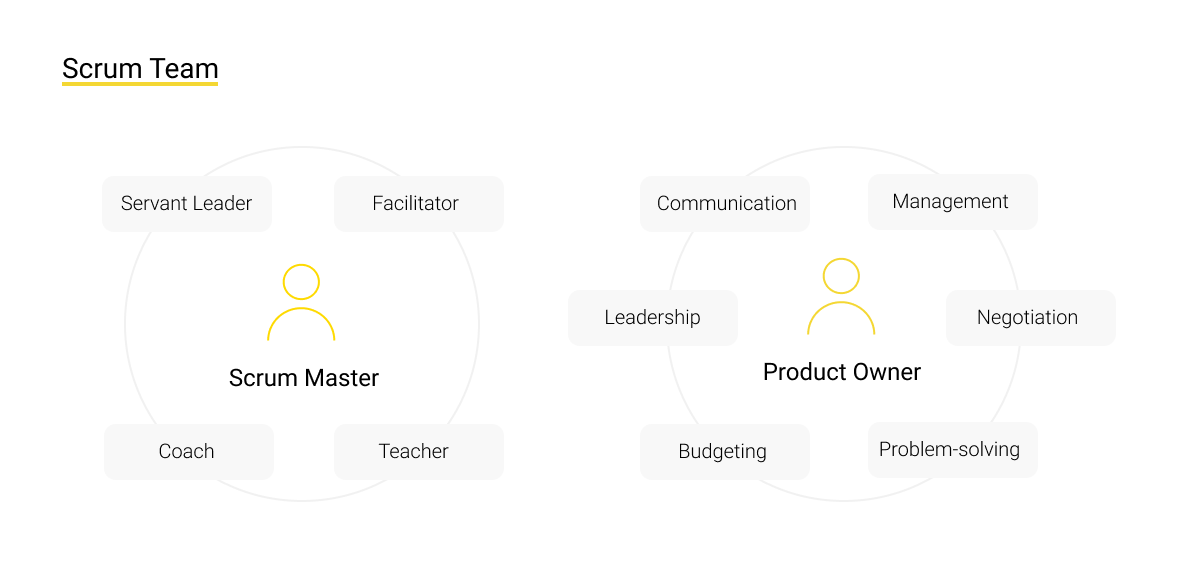- The scope of position
- The similarity between the job positions
- Scrum Master vs. Project Manager
- How to develop the mindset of a Scrum Master
- Take away
Although Scrum appeared about 30 years ago, those who find this methodology highly useful often face difficulties in putting it into practice. Therefore, each organization has specialists who assist in coping with this challenge. They make the Scrum guidelines clear to all participants of the project. Now and then, these experts come from other areas in IT, for example, project management. So the question might arise whether the company needs both a Scrum Master and a Project Manager. But before concluding, we should first figure out what their liabilities and proficiencies are, as well as which fundamental dissimilarities lie between them.
The scope of position
The Scrum Master carefully observes the Scrum Guide published by its founders. Those who teach Scrum confirm their expertise with dedicated certificates. These differ subject to the attainments each person has.
Such an expert interacts with developers, a Product Owner, and others within the organization. The Scrum Master coaches them on the adoption of Scrum and the basics of Agile.

One of the position responsibilities is motivating the team members to cope with hindrances to improve work results. The Scrum Master guides the Product Owner, stakeholders, management, and developers in their mutual collaboration. Also, this specialist is in charge of streamlining the development process and teaching others to follow Scrum in their work. As an expert in Scrum, they coach the team or the organization on how to work according to Scrum but, at the same time, don't dictate it.
The similarity between the job positions
When thinking about the connection between the two above-mentioned experts, nearly the only thing you’ll recall would be their leadership qualities. Comparing these job titles is somewhat like drawing an analogy between an apple and an orange or tennis and basketball. It means that both these positions belong to the same kind, but they are very diverse otherwise.
The main characteristic of the professionals who hold either of these positions is strong communication abilities. Therefore, they streamline the workflow effectively. They both have a fundamental goal in view while supporting the staff in fulfilling their daily duties.
At the same time, the Scrum Master is not so much a manager as a mentor, teacher, and guide. They don't give employees instructions on how to do things. Instead, a person in this position creates an environment for their self-organization and cross-functionality. Additionally, the Scrum Master facilitates the processes and coaches the team.
Scrum Master vs. Project Manager
 What are the core dissimilarities between these two jobs, then? Well, the basic differences lie in their goals, mindset, and area of responsibility.
What are the core dissimilarities between these two jobs, then? Well, the basic differences lie in their goals, mindset, and area of responsibility.
The Project Manager is a gifted time tamer. They are striving to finish the tasks within the defined time frame. A person in this position is proficient at convincingly negotiating with all kinds of people. That makes it possible to settle controversial matters and organize the work of others. Additionally, this professional must be talented in risk management. The job description for this role includes spotting and controlling various risks.
In contrast, the goal of the Scrum Master is to teach Scrum teams to spot, control, and predict various risks in order to timely cope with them. The expertise of the Scrum Master refers to proven skills in implementing the Scrum methodology and the Agile guidelines. This specialist must know how to apply this theory in complex scenarios. Moreover, such a teacher directs people by personal example. According to a new Scrum Guide, the Scrum Master is a true leader whose activity is primarily oriented on consulting others, and only secondarily on management.
The Project Manager has a greater responsibility for the overall project result than the Scrum Master. The work of the former is measured more clearly. The Project Manager as a position has a more imperative nature of communication with the team.
Сonversely, the Scrum Master doesn’t manage the team but prompts it with options. In reality, this professional succeeds when all those involved in the project achieve an understanding of Agile and Scrum and are willing to implement it (sometimes, desire is not equal to willingness).
Another substantial difference between the Scrum Master and Project Manager resides in their job duties. The former doesn’t work with documentation. This expert also has nothing to do with preparing business cases and managing changes, budget, resources, or with measuring the performance of employees.
The main task of the Project Manager is to manage the project as a whole. This professional leverages available resources to implement the customer’s idea in due time. The Project Manager is often the central point of life support for the processes in the project. As a leader, the Project Manager is supposed to make up a plan for the development, organize the team, set up the workflow, and prioritize tasks.
Then, this expert establishes communication between the teams and the customer. The Project Manager removes the obstacles encountered during project implementation, controls the quality of the product and its timely delivery. Moreover, this manager is in charge of drawing up and updating all sorts of documents, from Gantt charts to Risk registers.
To sum up, a Project Manager can be a Scrum Master, but the Scrum Master can’t fulfill the role of the Project Manager.
How to develop the mindset of a Scrum Master
Here are some helpful recommendations that the recognized Scrum Trainer Barry Overeem gave those that would like to embark on a new career. Firstly, he advised them to regularly visit the dedicated gatherings to strike up an acquaintance with like-minded people. He encouraged the entrants to make presentations and share the milestones of their journey in blog posts. Then, this experienced professional recommended the beginners not be afraid of starting with small changes. At the same time, they should continually review their progress to improve the processes.
Another valuable tip on how to learn about this methodology is to become a teacher. Preparation for a lecture gives a lot to those who are studying the material. Perhaps the most vital manual every lecturer must know is the Scrum Guide. Then, beginners need to get certified at some point and broaden their experience by exchanging it with the supervisors from other projects.
Finally, those who try out the new role should make value-based goals and outcomes their priorities. For example, the reduction of time to market, increase in product value, and improvement of team innovativeness.
Take away
The skills, accountabilities, and job descriptions of the two professionals, though overlapping to a certain extent, are still dramatically different.
Many companies consider project management as something authoritarian, smacking of mothballs, and old approaches to interaction with people and teams.
Scrum is not a magic wand either. It’s just a tool to streamline the processes. And it’s far from perfection, taking into consideration the constant development of the world. The publication of the Scrum Guide 2.0 only confirms this thesis. Like any tool, Scrum is subject to further configuration and adjustment (a keyword for Scrum) to the needs and requirements of each company. Then it will bring maximum efficiency.
The Scrum Guide teaches us that monitoring and adjustment are ongoing processes. That’s why a company will most likely need both a Project Manager and a Scrum Master, for example, during its transformation. But it’s also possible that just one of them will be enough.
If Scrum in a company exists only in words, then no Scrum Master can help it. In this case, a Project Manager is needed. And conversely, if the Scrum processes are well managed, and the entire company (or the project) is based on its principles, the Project Manager will most likely not fit into the picture. In that case, this expert can train to be the Product Owner or the Scrum Master. Another option is to become a Program Manager, a Portfolio Manager, a Delivery Director, etc.




